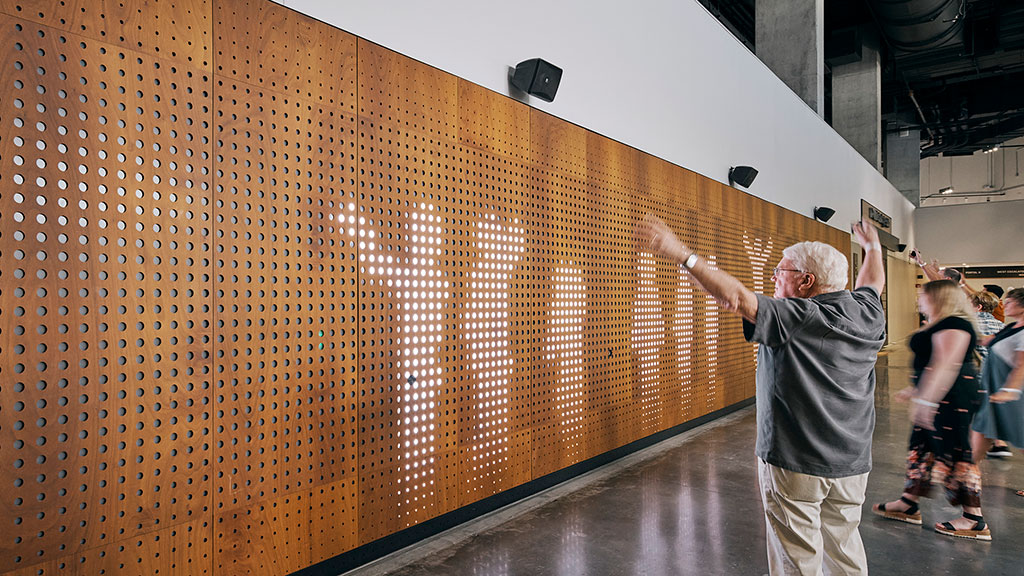Rethinking Engagement: Strategies for Immersive Design
May 23, 2023 | By Nick Hubbard, Sarah DiLeo, and Bonnie Reese
In today’s “attention economy,” where consumers are bombarded with constant streams of information, how can we, as designers, drive and sustain meaningful engagement between our clients’ spaces and their employees, partners, and customers? Through two years of research with digital and interactive content creators and audiences, we have come to a clear conclusion: immersive experience.
From the metaverse to multisensory installations, immersive experiences have gained buzz and popularity across digital and physical realms. But what do we mean by “immersive”?
When we began to investigate our first phase of research on Driving Inclusivity in Digital Content, we heard through qualitative interviews with respondents that design that invites engagement, and especially design that fosters a sense of agency and invites co-creation, is more inclusive. We found that when we talk about inclusivity in the context of digital experiences in the built environment, we are contending with a wide array of considerations — physical abilities, geographic locations, technological proficiency, gatekeepers and access, and identity. Navigating these considerations with sensitivity and intention is key to achieving successful engagement with a diverse audience.
This prompted us to embark on a second phase of research, focused on how the design of interactive public installations can drive meaningful user engagement across a range of identities and communities. The result was ultimately a redefinition of what immersion means for both designers and users.
Immersion is about going deeper — it creates a state of flow, play, and revelation. Enabled by trust, it takes people to places they haven’t been before, facilitating new experiences and growth. Engagement is essential for optimal life, work, and play, and true immersion creates the deepest form of engagement, which is essential for the relationships designers want to create between people, places, and organizations.
We discovered that true immersion is optimally achieved through a multi-stage virtuous cycle of exchanges between a visitor and the designed experience. Through a series of insights gleaned from our research, we’ve outlined a new framework for the engagement journey, a set of design process recommendations, and a paradigm shift in the definition of immersive experience — with the goal of inspiring and supporting sustained engagement for users of Digital Experience Design.
THE IMMERSIVE ENGAGEMENT JOURNEY
We have found that there is a clear set of steps in the immersive engagement journey — from learning about an experience to fully engaging with the experience and even being inspired to return or to share it with others.
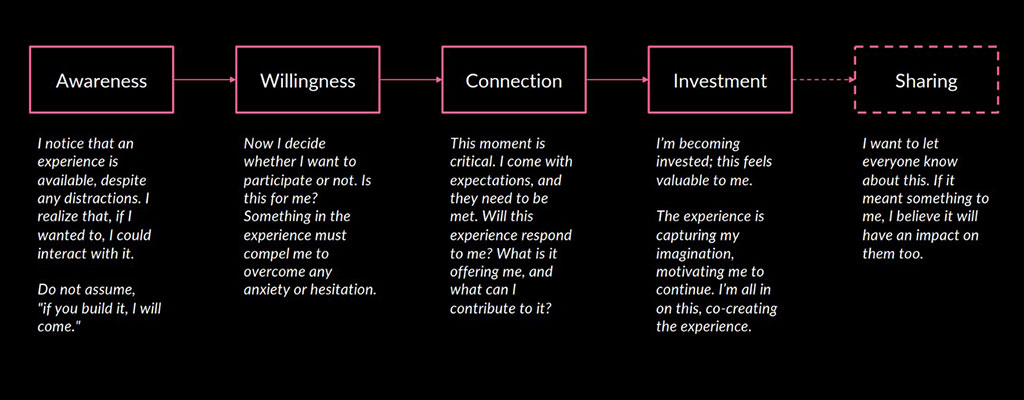
Step 1: Awareness
Making a wide audience aware requires including them on their terms.
There are so many competing stimuli in the wild, it’s easy for experiences to get overlooked unless the experience introduces itself in a way that’s both relevant and legible for visitors. Our research findings also illustrated the importance of digital extensions of physical installations (e.g., websites, social media, email marketing, or even custom apps) to create awareness and shareability.
Step 2: Willingness
‘Experience mode’ matters for users’ willingness to engage with content.
According to Gensler’s Experience Index, when a prospective visitor encounters an experience, the ‘mode’ that they are in when they encounter the installation predicts how likely they are to be open to engagement. For example, when in Discovery mode they’ll be primed to notice and explore an experience, but in Task mode, there will be high barriers to gaining their attention.
Diverse, inclusive programming builds trust and opens the door for engagement.
Content and event programming that addresses unique perspectives and includes underrepresented communities or needs builds trust with those audiences. When people recognize themselves in the space of engagement, they interpret an experience as “for them.”
Steps 3 & 4: Connection & Investment
Creating a safe space enables people to fully immerse.
Feeling both physically and psychologically safe is a prerequisite for engagement. Observing others engage with an experience normalizes and validates the interaction. Mediation, whether through explicit visual/aural instruction, guidepost responses within the experience, or docents, is a key component of inclusion.
Clear and immediate responsiveness drives sustained engagement.
Users are looking for immediate return on the investment they make by choosing to approach, observe, or interact with a digital experience.
Step 5: Sharing
Community networks are key to engagement loops.
Experiences that drive value for the participant prompt them to share with their networks. Endorsement by organizations, affinity groups, and personal connections pique interest in an experience and create self-sustaining engagement loops.
IMMERSIVE DESIGN RECOMMENDATIONS
By understanding the journey above, we can begin to design experiences using identifiable elements that help facilitate deepening engagement.
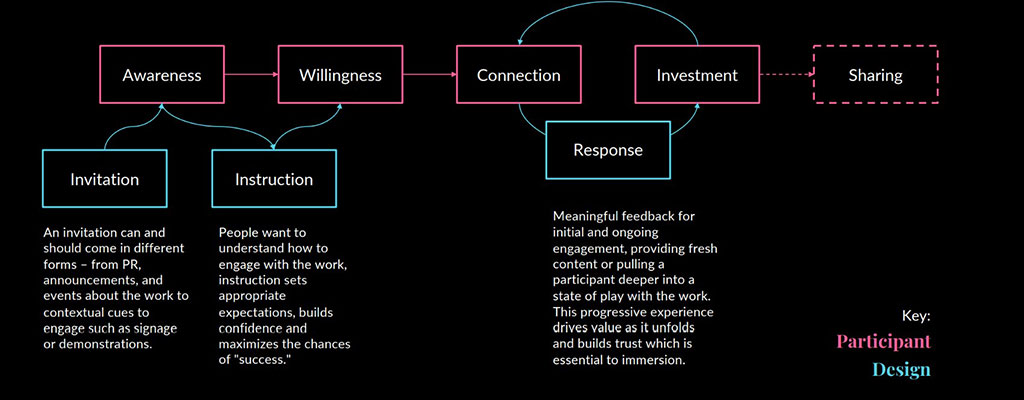
Here are a few simple recommendations for designers, intended to spark new ways of approaching experience design, expanding toolkits and best practices.
Invitation
Invitation is an essential component of experience design. A proactive invitation is not only instructive but is inherently inclusive in the act of crafting the invitation, given that it requires designers to think through the variety of potential users. Consider how the invitation might extend beyond the experience into other physical and digital spaces.
Instruction
While maintaining space for discovery, digital experience designers must include elements that explain — in a variety of ways — how to engage with confidence. The instruction should provide sufficient information to bridge the gap between a visitor’s awareness and their willingness to participate in an interactive experience. We can and should get creative about giving the clues, cues, or instructions necessary for onboarding, welcoming a broad set of people and enabling their full immersion. As with the experience itself, multimodal and multisensory instruction gives a wider pool of visitors a viable way in.
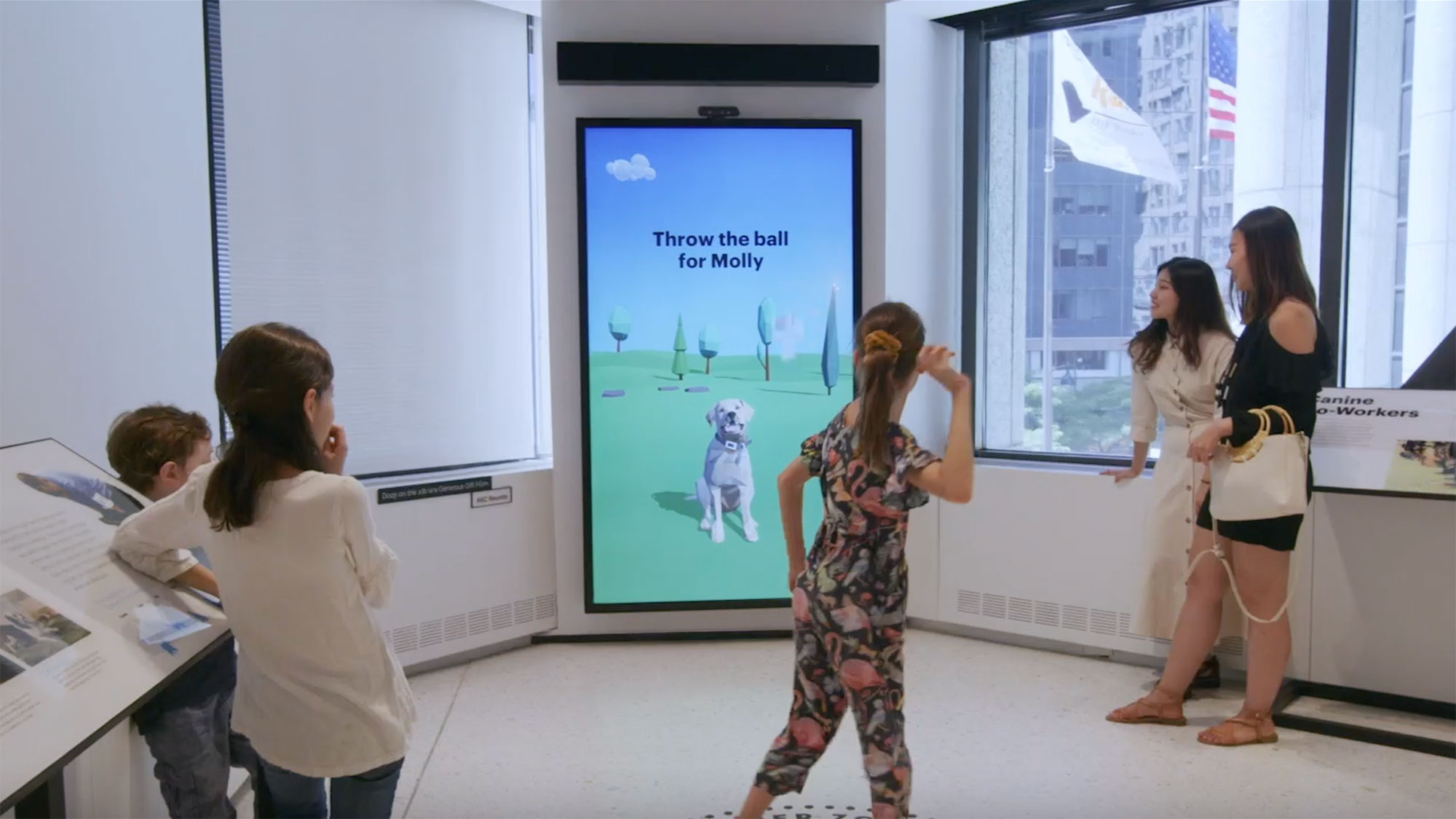
Response
When users do engage, the experience must respond with immediate and tangible gratification. One classic interactive response in public installations is mirroring; this is a trusted standard because it is so visceral.
After that initial response, it should evolve, becoming a give-and-take that allows for layers of complexity and nuance in the “conversation.” Successful responses add these layers through progressive disclosure, building intensity, or unlocking additional content and featured elements over time. Responses should make space for the user to carve their own path through exploration and play.
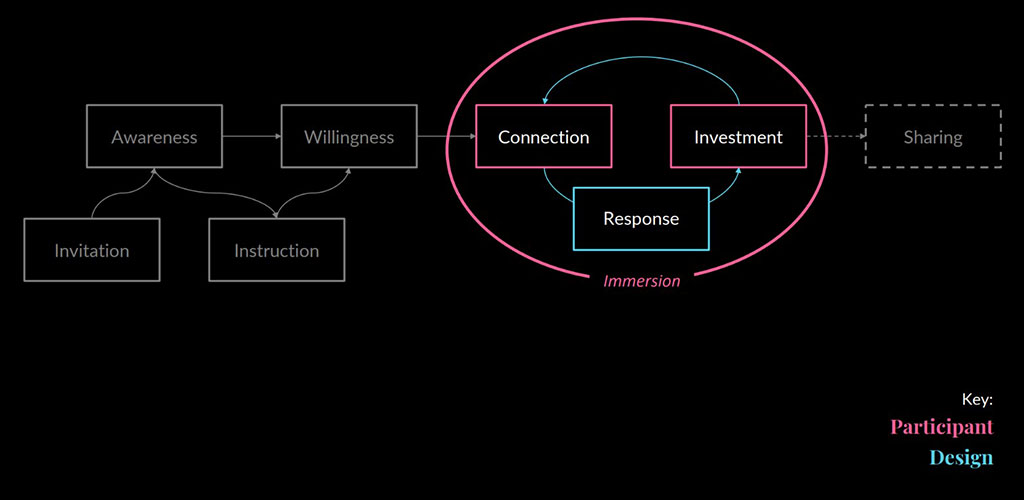
Immersive experiences are often identified based on the features of an installation — i.e., is it multisensory, multitouchpoint, or maximalist? Does it provide a sensory stimulus that surrounds the visitor? Our research suggests a new definition of immersion, one that flips the conceit from being defined by installation attributes to being defined by visitor engagement.
The state of immersion is achieved through the interplay between the visitor and the work, with the visitor acting as co-creator rather than consumer. We believe this stands true whether in physical or virtual space, and whether the work is interactive or ambient.
The visitor’s willingness to invest their time and trust leads to the virtuous cycle of connection, investment, and response. We define this state as immersion.
When we approach experience design with the mission of inclusivity, we can unlock the true power of shared immersive experiences: co-creation of narratives; collaborative ownership of a shared space; and experiences that evolve with the user and context to yield longevity and ongoing impact.
For media inquiries, email .
